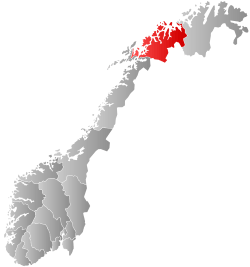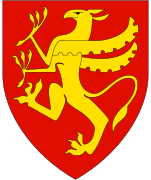Balsfjord
| Balsfjord kommune Báhccavuona suohkan Paatsivuonon komuuni | |||
|---|---|---|---|
| Municipality | |||
|
View of Nordkjosbotn | |||
| |||
 Balsfjord within Troms | |||
| Coordinates: 69°18′17″N 19°12′13″E / 69.30472°N 19.20361°ECoordinates: 69°18′17″N 19°12′13″E / 69.30472°N 19.20361°E | |||
| Country | Norway | ||
| County | Troms | ||
| District | Hålogaland | ||
| Established | 1860 | ||
| Administrative centre | Storsteinnes | ||
| Government | |||
| • Mayor (2015) | Gunda Johansen (Ap) | ||
| Area | |||
| • Total | 1,496.91 km2 (577.96 sq mi) | ||
| • Land | 1,440.83 km2 (556.31 sq mi) | ||
| • Water | 56.08 km2 (21.65 sq mi) 3.7% | ||
| Area rank | #52 in Norway | ||
| Population (2017) | |||
| • Total | 5,685 | ||
| • Rank | #185 in Norway | ||
| • Density | 3.9/km2 (10/sq mi) | ||
| • Change (10 years) | 2.1% | ||
| Demonym(s) | Balsfjording[1] | ||
| Time zone | UTC+01:00 (CET) | ||
| • Summer (DST) | UTC+02:00 (CEST) | ||
| ISO 3166 code | NO-1933 | ||
| Official language form | Bokmål | ||
| Website |
balsfjord | ||
Balsfjord (Northern Sami: Báhccavuotna or Kven: Paatsivuono) is a municipality in Troms county, Norway. The administrative centre of the municipality is the village of Storsteinnes. Other villages include Mestervik, Mortenhals, and Nordkjosbotn.
The 1,497-square-kilometre (578 sq mi) municipality is the 52nd largest by area out of the 422 municipalities in Norway. Balsfjord is the 185th most populous municipality in Norway with a population of 5,685. The municipality's population density is 3.9 inhabitants per square kilometre (10/sq mi) and its population has increased by 2.1% over the last decade.[2]
The municipality surrounds two fjords: Malangen and Balsfjorden, surrounded by comparatively rich farmlands under majestic peaks including the southern end of the Lyngen Alps.
General information

Balsfjord was originally a part of the great Tromsøe landdistrikt municipality, but it was separated from this in 1860 to form its own municipality. Balsfjord had an initial population of 3,610. On 1 January 1871, the northwestern part of the municipality (population: 1,425) was separated from it to create the new Malangen Municipality. This left Balsfjord with 2,255 inhabitants. On 1 January 1875, a part of Lyngen Municipality (population: 7) was transferred to Balsfjord. On 1 January 1905, a part of Balsfjord (population: 5) was transferred to Målselv Municipality.
During the 1960s, there were many municipal mergers across Norway due to the work of the Schei Committee. On 1 January 1964, most of Balsfjord Municipality was merged with most of neighboring Malangen municipality to form a new, larger municipality of Balsfjord (population: 6,993). Also on that day, the Skogli ved Heia area (population: 2) was transferred to the neighboring Målselv Municipality and the uninhabited Elvebakken farm was transferred to the neighboring Storfjord Municipality. On 1 January 1966, the Sørelvmo area of Balsfjord (population: 131) was transferred to Målselv Municipality.[3]
Name
The municipality is named after the local fjord: Balsfjorden (Northern Sami: Báhccavuotna). The meaning of the first element is uncertain, but is likely associated with the Norse god Baldr or the Old Norse word bals meaning lump.[4][5]
Coat of arms
The coat of arms is from modern times; they were granted on 21 November 1986. The arms show a yellow plough on a red background. This symbolizes the fact that the main source of income in the municipality is agriculture. The plough also symbolizes that the municipality is at the northernmost border on which grain can be grown in Norway.[6]
Churches
The Church of Norway has two parishes (sokn) within the municipality of Balsfjord. It is part of the Indre Troms prosti (deanery) in the Diocese of Nord-Hålogaland.
| Parish (Sokn) | Church Name | Location of the Church | Year Built |
|---|---|---|---|
| Balsfjord | Balsfjord Church | Balsfjord | 1856 |
| Nordkjosbotn Church | Nordkjosbotn | 1987 | |
| Storsteinnes Chapel | Storsteinnes | 1968 | |
| Malangen | Malangen Church | Mortenhals | 1853 |
| Mestervik Chapel | Mestervik | 1968 |
History
The Sami people were the original inhabitants of the area, but around 1800 new settlers came from Finland, from the coast, and from Southern Norway, and today very few traces of Sami culture survive. From the 18th century until the 20th century, trappers from Balsfjord were active in the Arctic, hunting in areas from Greenland to Novaya Zemlya.
Mindekirken movement
According to the book Tromsø City History (Norwegian: Tromsø by Histori) written by Nils Andreas Ytreberg (1896–1987) (published in Norwegian), during the mid-19th century, Balsfjord became the religious home of a group of "mindekirken" or "freechurch dissenters" who split from the state church parish in Tromsø. The mindekirken movement in the Troms region was led by the seminary student, Johannes Andreas Johannessen Bomstad (born at Balsfjord on 23 August 1821), who split from the state church at the age of 28, under the leadership of the first Norwegian mindekirken movement leader, Rev. Lammers from Oslo. In 1856, Bomstad and his original followers established their own church which they called the "Free Apostolic Christian Church" in Balsfjord.
"Rev. Bomstad" and his followers were said to have struggled and protested against the Tromsø state church minister and the Troms Bishop's religious rulings, eventually leading to a riot in the town of Tromsø, when state-church members yelled at Bomstad and his fellow dissenters to "go back to Kautokeino (A small village in the most northern districts of Norway)". In 1862, Bomstad led a group of "mindekirken colonists" to America, traveling first to Bergen, where they sailed in mid-May 1862 aboard the Sleipner, arriving at the inland port of Chicago, Illinois on 2 August 1862. Their voyage was also noteworthy as the first transatlantic voyage sailing directly from Europe to the port of Chicago (other previous transoceanic ships disembarked first at Quebec, Canada.) After arriving in Chicago, the mindekirken colonists traveled overland to the area of St. Peter, Minnesota, where they remained during the "Dakota War of 1862".
Rev. Bomstad left St. Peter traveling by mule to Kandiyohi County, Minnesota, where near the east bank of a lake (previously called "Lake Lillian"), he became the founding father of Lake Lillian, Minnesota in May 1864 (one hour ahead of the town's next settler, Mr. O.E. Hart, previously of New York). After staking his original claim, a month later on 3 June 1864, Rev. Bomstad led the rest of the colonists from St. Peter to their new settlement at Lake Lillian, where they built dugout shelters to live in that first year (on the site later occupied by the First M.E. Methodist Church of Lake Lillian.) A few months later he and his family finished building and moved into their log cabin home.

Government
All municipalities in Norway, including Balsfjord, are responsible for primary education (through 10th grade), outpatient health services, senior citizen services, unemployment and other social services, zoning, economic development, and municipal roads. The municipality is governed by a municipal council of elected representatives, which in turn elect a mayor.[7] The municipality falls under the Nord-Troms District Court and the Hålogaland Court of Appeal.
Municipal council
The municipal council (Kommunestyre) of Balsfjord is made up of 19 representatives that are elected to four year terms. Currently, the party breakdown is as follows:[8]
| Party Name | Name in Norwegian | Number of representatives | |
|---|---|---|---|
| Labour Party | Arbeiderpartiet | 10 | |
| Progress Party | Fremskrittspartiet | 2 | |
| Conservative Party | Høyre | 3 | |
| Christian Democratic Party | Kristelig Folkeparti | 1 | |
| Centre Party | Senterpartiet | 3 | |
| Total number of members: | 19 | ||
Climate
| Climate data for Storsteinnes | |||||||||||||
|---|---|---|---|---|---|---|---|---|---|---|---|---|---|
| Month | Jan | Feb | Mar | Apr | May | Jun | Jul | Aug | Sep | Oct | Nov | Dec | Year |
| Daily mean °C (°F) | −6.5 (20.3) |
−6.0 (21.2) |
−3.4 (25.9) |
0.5 (32.9) |
5.5 (41.9) |
10.4 (50.7) |
12.8 (55) |
11.6 (52.9) |
6.9 (44.4) |
2.3 (36.1) |
−2.7 (27.1) |
−5.2 (22.6) |
2.2 (36) |
| Average precipitation mm (inches) | 71 (2.8) |
67 (2.64) |
48 (1.89) |
45 (1.77) |
34 (1.34) |
50 (1.97) |
67 (2.64) |
68 (2.68) |
74 (2.91) |
94 (3.7) |
75 (2.95) |
75 (2.95) |
768 (30.24) |
| Average precipitation days (≥ 1 mm) | 10.4 | 10.6 | 8.8 | 9.1 | 7.6 | 9.6 | 12.7 | 12.4 | 13.1 | 13.4 | 12.3 | 12.0 | 132.0 |
| Source: Norwegian Meteorological Institute[9] | |||||||||||||
Economy
Farming is the single most important industry, although there is also some manufacturing. The Tine dairy factory at Storsteinnes is one of the largest producers of the Norwegian brown cheese (brunost). They also make their own brand of cheese, called Balsfjord, from goat's milk.
Transportation
European route E6 and European route E8 meet at the village of Nordkjosbotn, making it a major crossroad.
Attractions
Apart from the impressive scenery, attractions include the 6000-year-old rock carvings at Tennes (close to the Balsfjord Church), the old trading centre of Nordby, a Sami camp at Heia open over the summer months and the 18th century sawmill at Aursfjord. There is also a smaller field of rock carvings at Åsli. The Malangen Brygger resort on the water's edge has opened on the Malangen Peninsula and will expand further in May 2010 when a hotel and conference centre open.
Notable people
Notable people that were born or lived in Balsfjord include:
- Andreas Beck (1864–1914), explorer
- Gunda Johansen (born 1952), local politician
References
- ↑ "Navn på steder og personer: Innbyggjarnamn" (in Norwegian). Språkrådet. Retrieved 2015-12-01.
- ↑ Statistisk sentralbyrå (2017). "Table: 06913: Population 1 January and population changes during the calendar year (M)" (in Norwegian). Retrieved 2017-09-09.
- ↑ Jukvam, Dag (1999). "Historisk oversikt over endringer i kommune- og fylkesinndelingen" (PDF) (in Norwegian). Statistisk sentralbyrå.
- ↑ "Balsfjord" (in Norwegian). Store Norske Leksikon. 2010.
- ↑ Rygh, Oluf (1911). Norske gaardnavne: Troms amt (in Norwegian) (17 ed.). Kristiania, Norge: W. C. Fabritius & sønners bogtrikkeri. p. 125.
- ↑ "Civic heraldry of Norway - Norske Kommunevåpen". Heraldry of the World. Retrieved 2018-08-14.
- ↑ Hansen, Tore, ed. (2016-05-12). "kommunestyre". Store norske leksikon (in Norwegian). Kunnskapsforlaget. Retrieved 2018-08-07.
- ↑ "Table: 04813: Members of the local councils, by party/electoral list at the Municipal Council election (M)" (in Norwegian). Statistics Norway.
- ↑ "eKlima Web Portal". Norwegian Meteorological Institute. Archived from the original on 2004-06-14.
External links
- Municipal fact sheet from Statistics Norway





